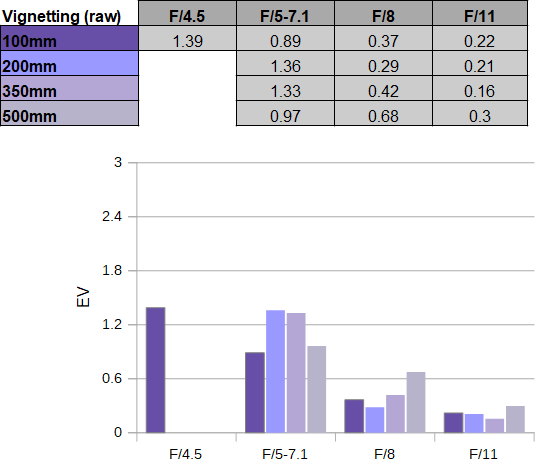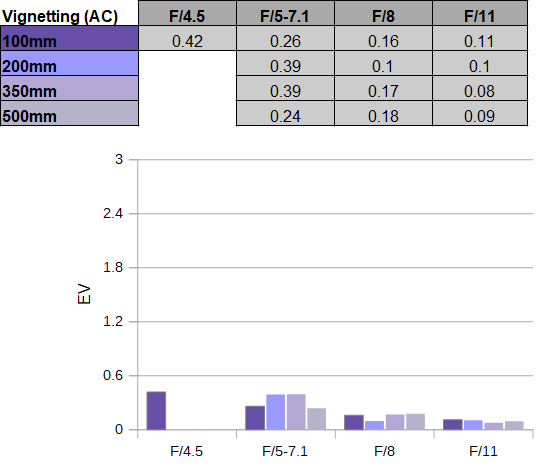|
Canon RF 100-500mm f/4.5-7.1 USM L IS - Review / Test Report - Analysis |
|
Lens Reviews -
Canon EOS (Full Format)
|
|
Page 2 of 3

Distortion
The RAW distortion characteristic of the Canon RF 100-500mm f/4.5-7.1 USM L IS is pretty good by today's mirrorless standards. At 100mm, images are essentially free of distortions. Beyond, there's an increasing amount of pincushion distortions with a peak of ~1.6% at 500mm.
With activated image auto-correction, the distortions are very well corrected, as you can see below.
Vignetting
The RAW vignetting is typical for a super tele zoom lens. At maximum aperture, the light falloff is visible at 1-1.3EV (f-stop). Stopping down by 1 f-stop dissolves this mostly.
 With activated image auto-correction, the light falloff is negligible by real-world standards.
With activated image auto-correction, the light falloff is negligible by real-world standards.

MTF (resolution)
The Canon RF 100-500mm f/4.5-7.1 USM L IS is impressively sharp throughout the range. At 100mm and 200mm the quality is on prime lens level with an excellent center and a very good to excellent outer image field. At 350mm there's a slight decrease in quality but the quality is still very high. As you may have guessed, diffraction is limiting the performance at 500mm. A max aperture of f/7.1 is beyond the optimum aperture on full format cameras. The quality is easily very good on a 30-megapixel sensor (used for testing). On an EOS R5, it'll be a bit more obvious in lab conditions - less so in real life.
The field curvature is very low. The centering quality of the tested sample was very good.
Please note that the MTF results are not directly comparable across the different systems!
Below is a simplified summary of the formal findings. The chart shows line widths per picture height (LW/PH) which can be taken as a measure of sharpness.
If you want to know more about the MTF50 figures, you may check out the corresponding Imatest Explanations

Chromatic Aberrations (CAs)
Lateral CAs (color shadows at the image borders) are low across the range. They are hovering around an average width of 1px at the image borders which is barely noticeable in RAW files and it's not an issue with activated image auto-correction.

Bokeh
Super-tele zoom lenses tend to have a rather busy bokeh, specifically with respect to the rendering of out-of-focus highlights. So how does the Canon RF 100-500mm f/4.5-7.1 USM L IS manage in this respect? It depends ...
Out-of-focus highlights are nicely rendered. The inner disc zone is pretty clean and there's just a slight outlining effect at the disc edges.
 The shape of the highlights tends to deteriorate towards the image borders - this is due to mechanical vignetting. The Canon lens is also affected by this as you can see below. The disc in the dead center is perfectly circular, but this changes from the mid-field. The corner discs are a bit irregular in shape but avoid edgy cat eyes at least. Stopping down corrects the shape towards a circular shape.
The general rendition in the focus transition zones is very smooth in the background (shown to the left below). The foreground blur can have more distinctive shadows at harsh contrast transitions (see e.g. the nose of the king to the right below).
The shape of the highlights tends to deteriorate towards the image borders - this is due to mechanical vignetting. The Canon lens is also affected by this as you can see below. The disc in the dead center is perfectly circular, but this changes from the mid-field. The corner discs are a bit irregular in shape but avoid edgy cat eyes at least. Stopping down corrects the shape towards a circular shape.
The general rendition in the focus transition zones is very smooth in the background (shown to the left below). The foreground blur can have more distinctive shadows at harsh contrast transitions (see e.g. the nose of the king to the right below).
 The above samples were taken at 100mm. However, the bokeh can vary across the zoom range. Below is a crop of a real-world image taken at a longer focal length. As you can see the rendering is quite harsh in this example. This is an extreme example but it's not the only image where we have seen this.
The above samples were taken at 100mm. However, the bokeh can vary across the zoom range. Below is a crop of a real-world image taken at a longer focal length. As you can see the rendering is quite harsh in this example. This is an extreme example but it's not the only image where we have seen this.

|